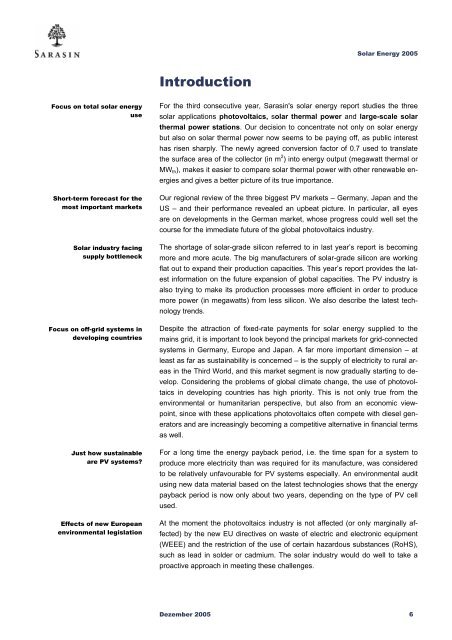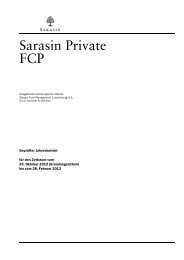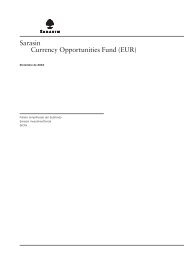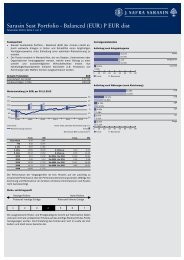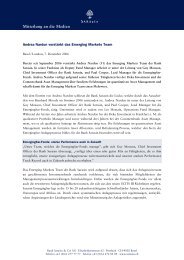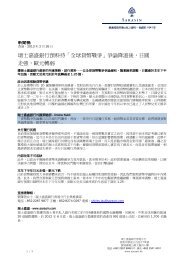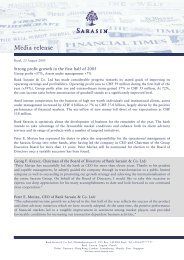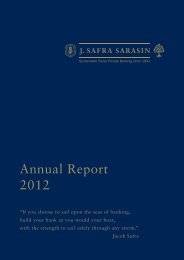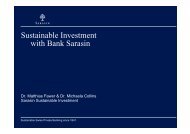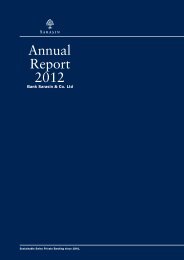Sustainability Report - Bank Sarasin-Alpen
Sustainability Report - Bank Sarasin-Alpen
Sustainability Report - Bank Sarasin-Alpen
Create successful ePaper yourself
Turn your PDF publications into a flip-book with our unique Google optimized e-Paper software.
Solar Energy 2005<br />
Introduction<br />
Focus on total solar energy<br />
use<br />
Short-term forecast for the<br />
most important markets<br />
Solar industry facing<br />
supply bottleneck<br />
Focus on off-grid systems in<br />
developing countries<br />
Just how sustainable<br />
are PV systems?<br />
Effects of new European<br />
environmental legislation<br />
For the third consecutive year, <strong>Sarasin</strong>'s solar energy report studies the three<br />
solar applications photovoltaics, solar thermal power and large-scale solar<br />
thermal power stations. Our decision to concentrate not only on solar energy<br />
but also on solar thermal power now seems to be paying off, as public interest<br />
has risen sharply. The newly agreed conversion factor of 0.7 used to translate<br />
the surface area of the collector (in m 2 ) into energy output (megawatt thermal or<br />
MW th ), makes it easier to compare solar thermal power with other renewable energies<br />
and gives a better picture of its true importance.<br />
Our regional review of the three biggest PV markets – Germany, Japan and the<br />
US – and their performance revealed an upbeat picture. In particular, all eyes<br />
are on developments in the German market, whose progress could well set the<br />
course for the immediate future of the global photovoltaics industry.<br />
The shortage of solar-grade silicon referred to in last year’s report is becoming<br />
more and more acute. The big manufacturers of solar-grade silicon are working<br />
flat out to expand their production capacities. This year’s report provides the latest<br />
information on the future expansion of global capacities. The PV industry is<br />
also trying to make its production processes more efficient in order to produce<br />
more power (in megawatts) from less silicon. We also describe the latest technology<br />
trends.<br />
Despite the attraction of fixed-rate payments for solar energy supplied to the<br />
mains grid, it is important to look beyond the principal markets for grid-connected<br />
systems in Germany, Europe and Japan. A far more important dimension – at<br />
least as far as sustainability is concerned – is the supply of electricity to rural areas<br />
in the Third World, and this market segment is now gradually starting to develop.<br />
Considering the problems of global climate change, the use of photovoltaics<br />
in developing countries has high priority. This is not only true from the<br />
environmental or humanitarian perspective, but also from an economic viewpoint,<br />
since with these applications photovoltaics often compete with diesel generators<br />
and are increasingly becoming a competitive alternative in financial terms<br />
as well.<br />
For a long time the energy payback period, i.e. the time span for a system to<br />
produce more electricity than was required for its manufacture, was considered<br />
to be relatively unfavourable for PV systems especially. An environmental audit<br />
using new data material based on the latest technologies shows that the energy<br />
payback period is now only about two years, depending on the type of PV cell<br />
used.<br />
At the moment the photovoltaics industry is not affected (or only marginally affected)<br />
by the new EU directives on waste of electric and electronic equipment<br />
(WEEE) and the restriction of the use of certain hazardous substances (RoHS),<br />
such as lead in solder or cadmium. The solar industry would do well to take a<br />
proactive approach in meeting these challenges.<br />
Dezember 2005 6


